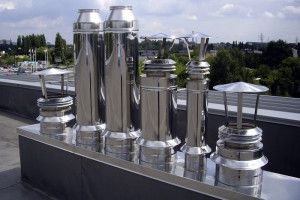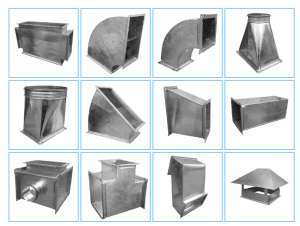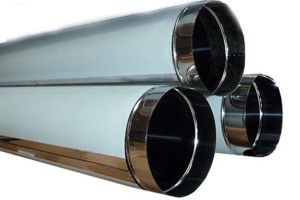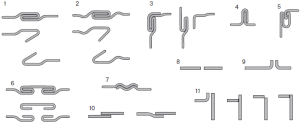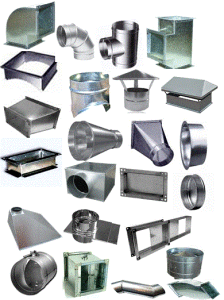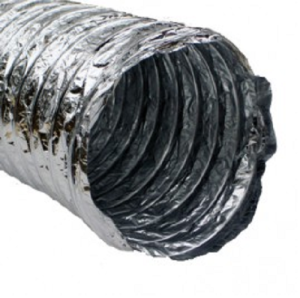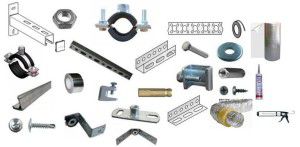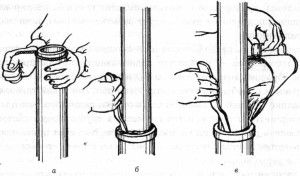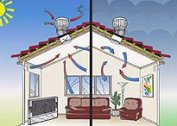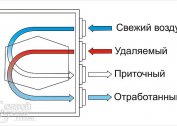Sheet metal ventilation elements are practical, durable and easy to install. Due to these and other properties, they are very widely used in industrial ventilation systems. Private homeowners tend to prefer other materials.
Read more about the advantages, disadvantages and features of the operation of metal ventilation ducts, pipes and fittings below.
Types of metal ventilation elements
All the main and auxiliary components for the ventilation system are made of metal:
- air ducts;
- nipple;
- umbrellas;
- tires;
- stubs;
- bends;
- adapters;
- tees;
- sidebars
- metal ventilation grids and grilles.
Ducts made of metal
Ducts form the mains for transporting air flows. Outlets of ducts are covered by overhead metal ventilation grilles.
According to the shape of the section, they can be:
- rectangular;
- round.
By manufacturing technology:
- straight-seam;
- spiral-wound.
Longitudinal metal ventilation ducts made of thin steel sheet. The edges of the whole sheet are fastened with folds (if the sheet thickness is not more than 1.4 mm) or by welding. The seam connection is not always tight enough and requires the use of additional material.
Welded joint is more laborious, but does not have similar disadvantages. Longitudinal ducts are widely used to create short, straight sections.
They are produced in standard length and diameter in two classes of tightness: “N” and “P”. Class “H” or “Normal” indicates the likelihood of small air leaks. Pipes of class “P” are additionally sealed.
Spiral air ducts made of metal tape, which is curled into a tube on special equipment. A special rib gives additional rigidity to large diameter pipes.
In residential premises, rectangular ducts are more often used, which are easier to fit into the interior. However, such pipes create greater resistance to air. Therefore, in powerful industrial systems, they prefer round ducts with the best aerodynamic characteristics.
Flexible and semi-rigid ducts are often installed on small sections with many turns. Since the ribs of the corrugation create the greatest resistance to the movement of air.
Flexible metal ducts
The technology of their production is completely different from the types described above, and the material is aluminum foil.
Flexible metal ventilation ducts can be:
- isolated;
- uninsulated.
They are a spiral frame made of rigid steel wire, on which several layers of laminated lavsan film and aluminum foil are worn. Insulated flexible metal ducts for ventilation are wrapped in a layer of mineral wool 3 cm thick, which is covered on top with an additional layer of foil.
Metal fittings
Shaped metal products allow you to connect air ducts of various diameters and cross-sections, perform turns and a variety of wiring. Using umbrellas or metal ventilation grilles, the outlets of the ventilation pipes are drawn out. And metal ventilation nets protect the air ducts from small animals and debris.
Shaped parts produce the most diverse types and forms. Often, the main costs for installing ventilation are not in the ducts, but in the fittings. They can be of rectangular or circular cross-section, of various diameters and are selected for air ducts.
To assemble a standard duct network, you need the following minimum set of fittings:
- bends at 45 and 90 degrees;
- duck;
- nipple;
- tee;
- sidebar;
- stub.
Metal ventilation grilles are superimposed on the outlet of the duct from the street. External metal ventilation grilles can be equipped with a blind system. In winter or downtime, the duct is well protected from debris and dust. Such devices must be installed at large facilities.
In residential buildings, it is enough to cover the exit with a metal mesh for ventilation. Unpleasant odors and dust are removed from the toilet or kitchen through the metal ventilation mesh.
Sometimes the outlet of the ventilation pipes is located in the floor (for example), in some industries or in saunas and is covered with a metal ventilation grill for the floor. Most often, a metal grill is built into the floor to create an area of increased pressure in the working areas.
Metals for ventilation elements
Metal ventilation ducts are made of corrosion resistant sheets:
- stainless steel;
- galvanized steel;
- aluminum.
Stainless steel metal pipes for ventilation very durable and meet the highest sanitary and hygienic requirements:
- withstand up to +500 degrees Celsius;
- fungus and mold are not populated in them;
- resistant to direct fire;
- resistant to moisture;
- resistant to aggressive environments.
Metal steel ducts are used for ventilation of hospitals and clinics, schools, as well as in industries with high radiation levels, high temperatures and humidity.
Galvanized metal ventilation pipes are made of cold rolled steel with a sheet thickness of 0.5 to 1.25 mm, less often a hot rolled sheet is not thicker than 0.9 mm. In the second case, the steel is additionally treated with a primer.
- withstand up to +85 degrees Celsius;
- resistant to humidity up to 60%;
- biologically stable;
- relatively inexpensive;
- easily assembled into the structure, leaky sections are replaced;
- have low weight.
Due to these properties, galvanized metal ventilation pipes are often installed in warehouses and dry plants.
Metal ventilation ducts are interconnected by flanges or nipples.
Aluminum ducts are flexible or semi-rigid. They are made of aluminum foil of different thicknesses (from 0.08 to 0.12 mm). The main advantage of metal aluminum air ducts for ventilation is the ability to bend them at any angle:
- withstand temperatures up to +135 degrees (flexible) and up to +300 degrees (semi-rigid);
- resistant to aggressive environments and ultraviolet (semi-rigid);
- can be installed in catering facilities, dryers and ironing rooms;
- Do not need grounding.
Semi-rigid ducts can be installed outdoors.
Aluminum metal ducts for ventilation are practical, lightweight and inexpensive. They are perfectly bent, fastened together with a triple lock. A flexible metal duct for ventilation can be compressed and stretched several times.In a compressed state, flexible and semi-rigid ducts are convenient to transport and store, their length is 50 cm. When stretched, it reaches 3 meters.
Rules for installing ventilation elements
Before starting the installation of the ventilation system, it is necessary to examine the room and select the best method of fastening.
For fastening metal ducts use:
- clamps;
- hairpins;
- corners;
- bolts and nuts.
Sometimes you have to resort to welding.
Installation of flexible metal pipes has its own rules:
- To reduce pressure losses inside the pipe, mount them only in a stretched condition;
- Excess pieces are more convenient to cut off immediately;
- It is advisable to use wide brackets that do not pinch the pipe;
- To pass through the walls, solid adapters or metal sleeves are necessarily used.
Distribute suspension points using the following rules:
- when cornering, the bending radius should be less than the diameter of the duct;
- sagging of not more than 5 centimeters per linear meter is allowed;
- when installing the pipe vertically, there must be a distance of 1 - 1.8 meters between the fasteners.
The connection of ducts and fittings of ventilation among themselves
To connect the elements of circular cross section are used:
- Flange mount. To ensure a tight seam, the flanges are flanged. Flange holes must remain free;
- Bandage mount rarely used, mainly in hazardous industries. It provides complete sealing. First, the ends of the ducts are flanged, then put on a bandage. It is filled with a chemically neutral substance or ordinary sealant. The technology is simple and inexpensive, but the manufacture of bandages is quite expensive. Therefore, it does not find wide application;
- Coupling or nipple. Made with or without rubber seal. If there is no elastic, installation requires sealant treatment. Particular attention should be paid to its composition and quality when placing the system outside the building or in aggressive environments;
- Trumpet - The simplest and most widely used compound. A smaller pipe is inserted into a larger pipe.
It is provided as follows:
- the duct is made in the shape of a cone;
- one end of the duct is slightly narrowed, the other is expanded.
To connect rectangular elements are used:
- Flanges that are fastened with rivets or spot welding. The second option is simpler and more common, although it leads to a quick burst of the pipe in the weld areas;
- Tires are the most common type of fastening in general exchange systems. The sides are interconnected by corner inserts. On ducts of large diameters (200 mm or more), a tightening element is certainly mounted.
When connecting rectangular ventilation pipes, it is imperative to seal the corners. Connections are laid with tapes from:
- monolithic rubber;
- foam rubber;
- polymer mastic tow.
Cons of metal ventilation elements
- More expensive than plastic;
- During manufacture, roughnesses may appear on the internal surfaces, increasing air resistance;
- The relatively large weight of the structure, because of which it is necessary to use special fasteners;
- Corrosion susceptibility of black steel ducts;
- Aerodynamic noise.
Metal ventilation from the external grille to the air ducts was a bit squeezed on the market by polymer products that do not have the above disadvantages. However, a better material for powerful air exchange systems than metal does not exist today.
This is how longitudinal air ducts are made on the most modern machines:
